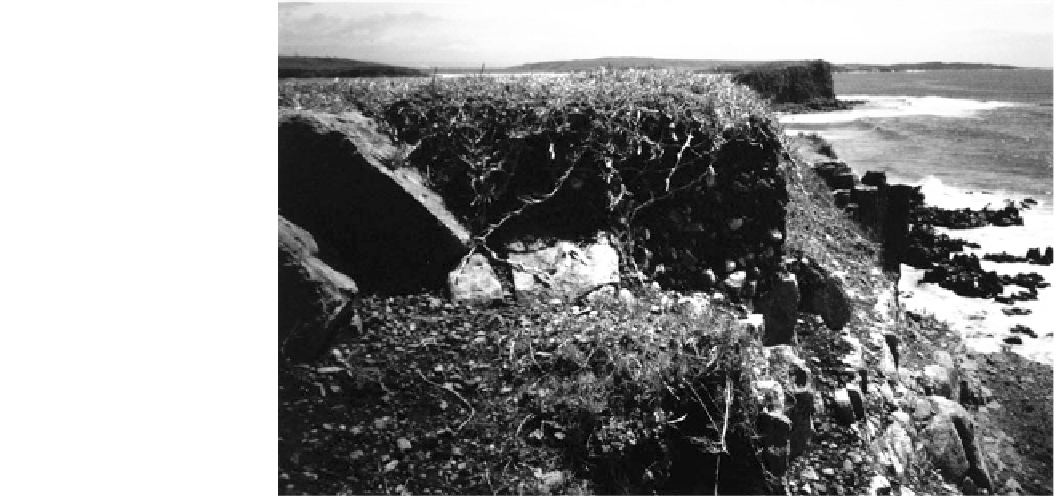Geoscience Reference
In-Depth Information
Fig. 3.7
A chaotically sorted
dump deposit on Minnamurra
Headland, New South Wales,
Australia. The deposit, set in a
mud matrix, lies on basalt, yet
contains rounded metamorphic
beach-worn pebbles. Similar
deposits on adjacent headlands
contain shell bits. The site is
40 m above sea level on a coast
where sea level has been no more
than 1-2 m higher than the
present over the past 7000 years
pyroclastic density currents or ash clouds emanating from
volcanic eruptions (Branney and Zalasiewicz
1999
). In a
pyroclastic flow, fine particles are suspended and trans-
ported by turbulent whirlwinds of gas. While appearing as
choking clouds of ash, the particles are so widely spaced
that they rarely collide. As these turbulent eddies pass over
a spot, they can deposit alternating layers of coarse and fine
sediment as the velocity of the current waxes and wanes in a
similar fashion to gusts of wind. Where the cloud meets the
ground, conditions are different. Sediment concentrations
increase and sediment particles ranging in size from silts to
boulders undergo countless collisions. The momentum of
the flow is equalized between the particles and the flowing
current of air. In some cases, the grains may flow inde-
pendent of any fluid, a phenomenon known as granular
flow. Granular flow tends to expel coarse particles to the
surface; however, if fluid moves upwards through the flow,
then a process called fluidization may allow sediment par-
ticles in dense slurries to move as a fluid and remain
unsorted. Different processes probably operate at different
levels in pyroclastic flows. Turbulence lifts finer particles
into the current higher up, while at ground level it enhances
fluidization. Similarly, the falling out of particles from
slurries near the ground entraps smaller particles into a
deposit while expelling water. The latter process also
enhances fluidization. From time to time, turbulent vortices
penetrate to the bed, allowing the deposition of alternating
layers of fine and coarse material. The resulting deposit is
disorganized or chaotic in appearance, contains a wide
range of particle sizes and may show layering.
All of these characteristics have been proposed for tsu-
nami dump deposits with water taking the place of gas
(Coleman
1968
; Bryant et al.
1992
,
1997
). Alternating
layers of fine and coarse sands can be found as small, eroded
blocks embedded in chaotically sorted piles of bouldery
sand. The layers were deposited from downward turbulent
pulses of water that penetrated to the bed. Chipped gravels
and shells form deposits that can also contain fragments that
show no evidence of violent transport. The former are
milled by the myriad of collisions occurring in granular
flow towards the base of the current, while the latter have
settled from the less-dense upper regions of flow. Preser-
vation of fragile particles indicates that deposition must
have been rapid. Mud clasts are evidence of the erosive
power of turbulent vortices impinging upon the bed. Some
of the mud clasts are caught in the granular flow and are
disaggregated to form the mud matrix. Some clasts are
suspended higher into the less dense part of the flow and are
later mixed into the deposit unscathed. Not only do turbu-
lent vortices create spatial variation in the internal fabric of
the deposits, they also account for the rapid spatial variation
in the degree of erosion of the landscape upstream. Hence,
the eroded upstream sides of headlands that provide the
material incorporated into dump deposits can still evince
weathered soil profiles within meters of bedrock surfaces
that have undergone the most intense erosion by vortices.
The rocky headlands of the New South Wales coast also
show an unusual variation of dump deposits with a strong
Aboriginal constituent (Bryant et al.
1992
). At 16 locations,
Aboriginal kitchen middens have been reworked by tsu-
nami. Kitchen middens are trash heaps containing discon-
tinuous layers of edible shell species mixed with charcoal,
bone fragments, and artifact stone chips, set in humic-rich
sands. All of the disturbed sites incorporate, as an added
component, marine shell grit, water-worn shells, rounded
pebbles, or pumice. Humus is usually missing from the

